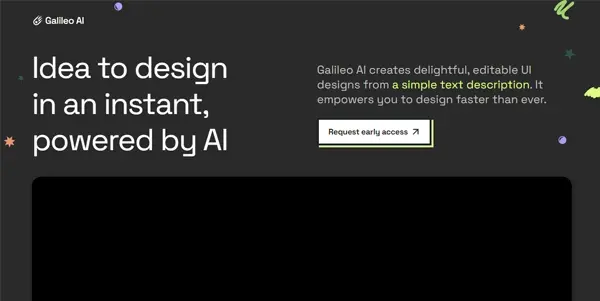Galileo AI

A no-code AI design tool that generates user interfaces (UI) Works via a text prompt
Galileo AI: Revolutionizing UI Design with No-Code AI
Galileo AI is a groundbreaking no-code AI design tool that empowers users to generate user interfaces (UIs) simply by describing them in text. This innovative approach bypasses traditional coding and design software, significantly streamlining the UI development process for both experienced designers and novices alike. By leveraging the power of artificial intelligence, Galileo AI aims to democratize UI design and accelerate the creation of visually appealing and functional interfaces.
What Galileo AI Does
At its core, Galileo AI translates natural language descriptions into functional UI designs. You provide a textual prompt outlining your desired UI elements, features, and overall aesthetic, and the AI generates a corresponding design. This could range from a simple button layout to a complex dashboard, all created without writing a single line of code. The generated designs are interactive prototypes, allowing users to test the functionality and refine the design iteratively.
Main Features and Benefits
- No-Code Development: The most significant benefit is the elimination of coding. This makes UI design accessible to a broader audience, including individuals without programming expertise.
- Text-Based Design: Users describe their desired UI using natural language, making the design process intuitive and efficient.
- Interactive Prototyping: The generated designs are not just static mockups; they are interactive prototypes, allowing for immediate testing and feedback.
- Rapid Iteration: Changes and refinements can be made quickly and easily through iterative text prompts, drastically reducing design time.
- AI-Powered Suggestions: Galileo AI can offer suggestions and optimizations based on best practices and design principles, further enhancing the quality of the generated UIs.
- Customization Options: While AI generates the initial design, users retain significant control over customization, allowing for personalization and fine-tuning.
Use Cases and Applications
Galileo AI finds applications in diverse fields:
- Web Application Development: Quickly create prototypes and MVPs (Minimum Viable Products) for web applications.
- Mobile App Design: Design user interfaces for iOS and Android apps without coding skills.
- Internal Tool Development: Create custom internal tools for businesses with ease.
- Rapid Prototyping: Experiment with various design approaches quickly and efficiently.
- UI/UX Design: Assist experienced designers in accelerating the initial design phase.
- Education: Teach UI design concepts and principles in a hands-on, accessible manner.
Comparison to Similar Tools
While several other AI design tools exist, Galileo AI distinguishes itself through its focus on pure text-based input and its emphasis on generating fully interactive prototypes. Other tools may require visual input or offer limited interactivity. A direct comparison would require a thorough feature-by-feature analysis against specific competitors, such as tools focusing on generating code from design mockups or those offering limited AI-assisted design features. However, Galileo's unique approach of translating natural language directly into interactive prototypes sets it apart.
Pricing Information
Galileo AI operates on a paid subscription model. Specific pricing tiers and features offered at each level are available on the Galileo AI website. It is recommended to check their official website for the most up-to-date pricing information as plans and costs can change.
Conclusion
Galileo AI represents a significant advancement in UI design technology. By leveraging the power of AI and a user-friendly no-code interface, it empowers users of all skill levels to create sophisticated and functional UIs quickly and efficiently. Its unique text-based input and interactive prototype generation capabilities position it as a valuable tool for individuals and businesses looking to streamline their UI development processes. The potential applications are vast, and as the technology evolves, we can anticipate even greater capabilities and wider adoption in the future.